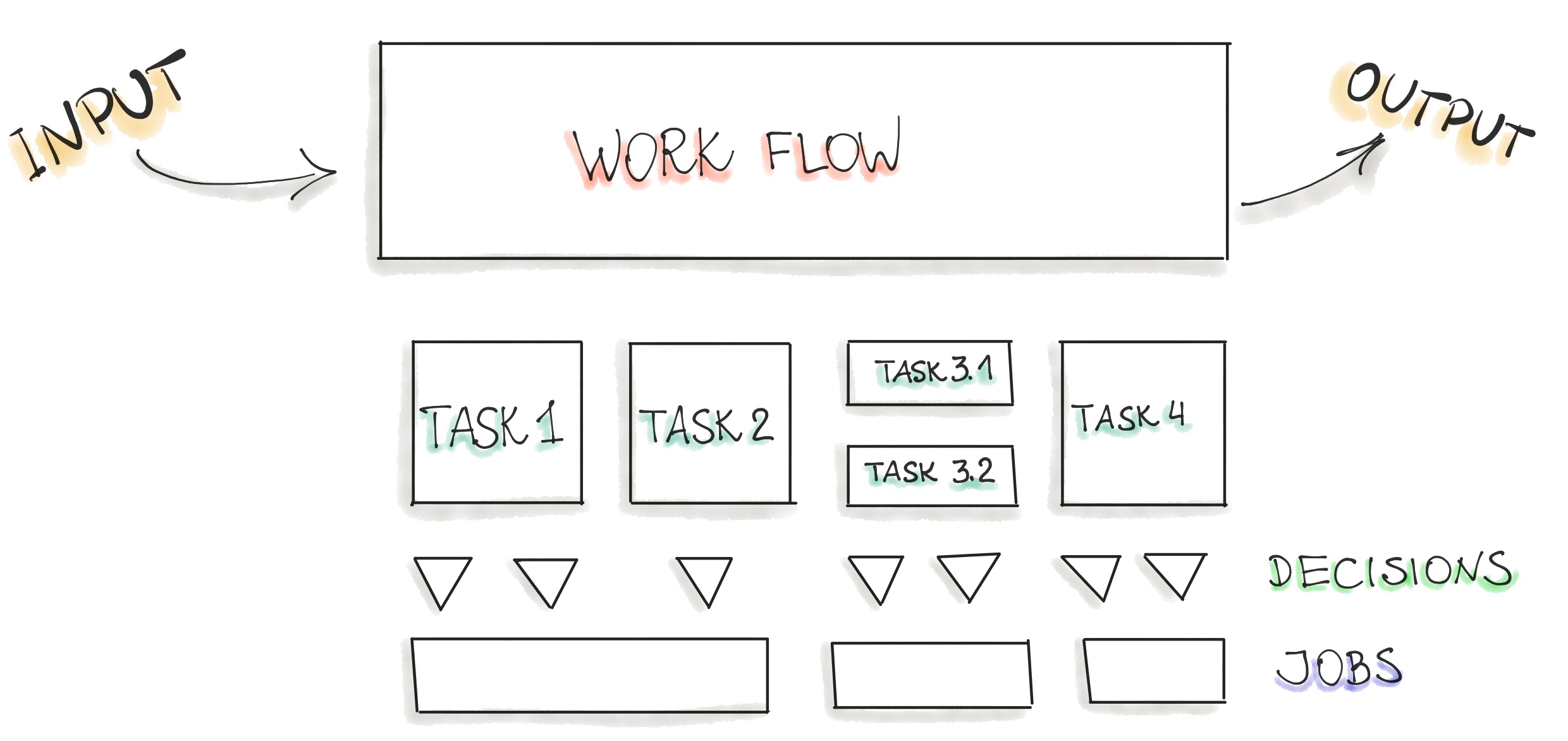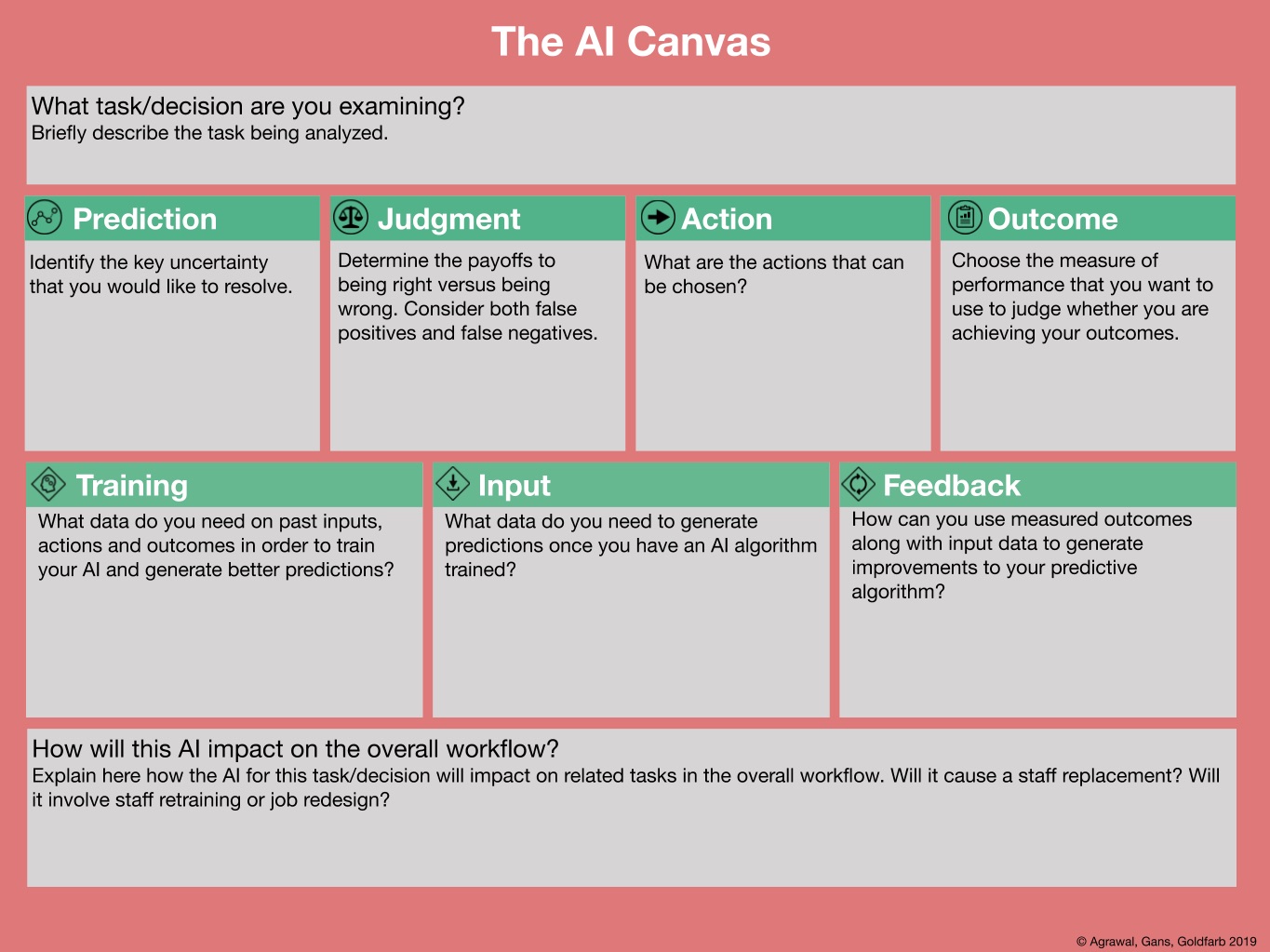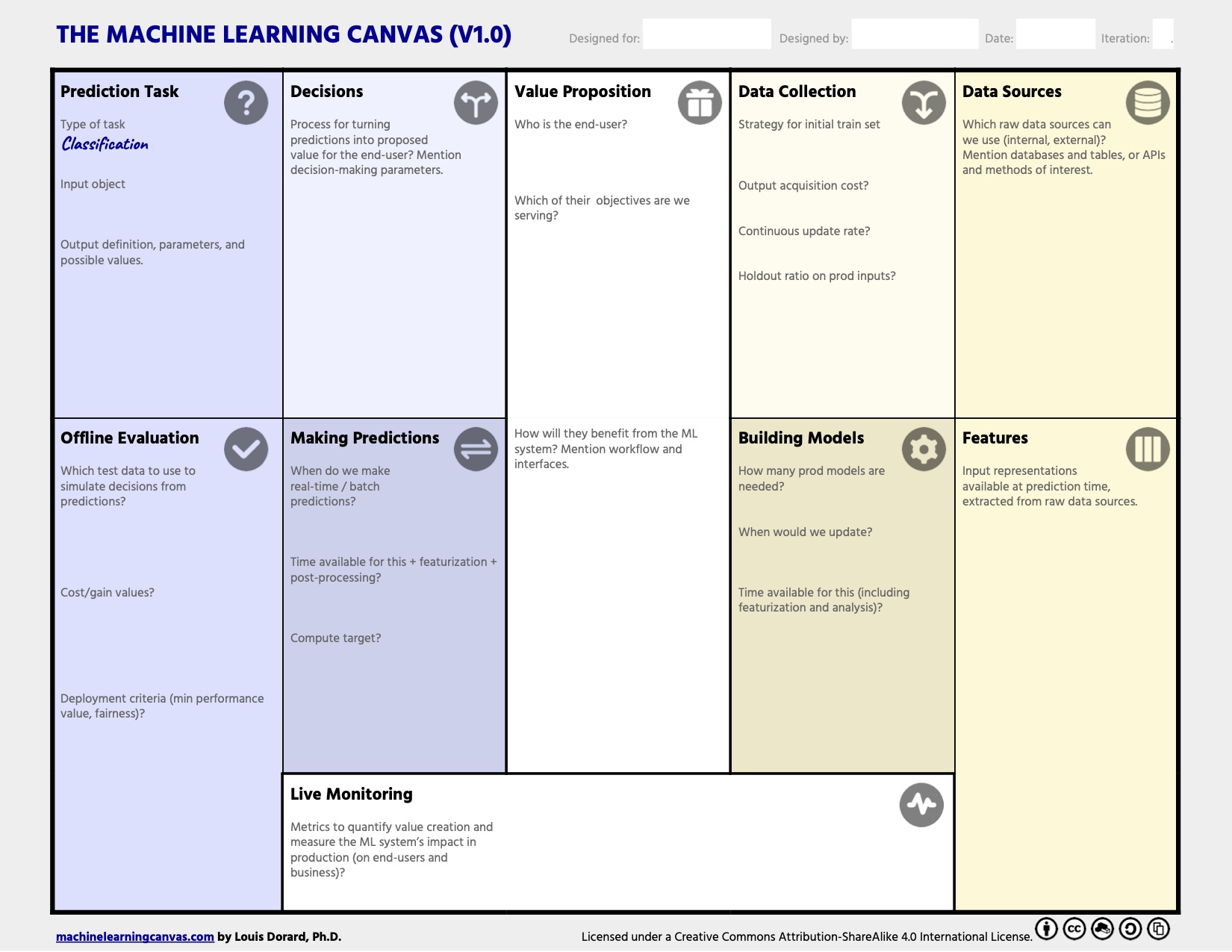“What is the business problem that we are trying to solve here?”
The most important phase in any software project is to understand the business problem and create requirements. ML-based software is no different here. The initial step includes a thorough study of business problems and requirements. These requirements are translated into the model objectives and the model outputs. Possible errors and minimum success for launching need to be specified. The most useful question to continue working on the AI/ML solution is “how costly are wrong predictions?” Answering that question will define the feasibility of the ML project.
Work Flow Decomposition
Each task of the entire business process needs to be decomposed into its constituent elements in order to see where prediction (ML model) can be introduced.

To anwer the question “how to implement AI/ML”, we follow the next steps:
- Identify the concrete process that might be powered by AI/ML (see the Figure above).
- Decompose that process into a directed graph of tasks.
- Identify where humans can be removed from the task, meaning, what task can be replaced by a prediction element such as ML model?
- Estime the ROI for implementing an AI/ML tool to perform each task.
- Rank-order the AI/ML implementation for each task in terms of ROI.
- Start from the top of the list and structure the AI/ML implementation by completing either the AI Canvas or the Machine Learning Canvas.
The AI Canvas or its alternative, the Machine Learning Canvas, assist and help to structure the breakdown process. They also help to articulate exactly what is needed to predict and how we react on errors made by the prediction algorithm.
AI Canvas
The AI Canvas was proposed by A. Agrawal et. al in their book “Prediction Machines. The Simple Economics of Artificial Intelligence.” 2018, and “is an aid for contemplating, building, and assessing AI tools”. The example of such canvas and the description of each component is provided in the Figure below:

Machine Learning Canvas
While the above AI canvas represents a high-level structure of the ML/AI implementation, at some point we would like to specify both the vision for the ML system and the specifics of the system. To achieve those goals there is another tool, the Machine Learning Canvas, as suggested by Louis Dorard. This canvas structures the ML project and helps to specify the core requirements to realise the project. Initially, we identify the objective by answering a question what do we want to achieve for the end-users of the predictive system? Next, we connect the business goal to the ML task.
The central part of the canvas is the Value Proposition building block, which describes products or services that create some value for customers. Typically, we answer the following questions: What problems are we trying to solve? Why is it important? Who is the end-user of our system? What value does the ML project deliver to the end-user? How will they use your outputs/predictions?
The remaining canvas is divided into three broad categories: Learning, Prediction, and Evaluation. The Learning category is responsible to specify how the ML model will be learned. The Prediction part describes how the prediction is performed. Finally, the Evaluation category contains methods and metrics for the ML model and the system evaluation. The following machine learning canvas is an example provided by Louis Dorard:

In total, the Machine Learning Canvas is structured as ten compound blocks, such as Value Proposition, Data Sources, Prediction Task, Features (Engineering), Offline Evaluation, Decisions, Making Predictions, Collecting Data, Building Models, and Live Evaluation and Monitoring. Each of those blocks is focused on one aspect of the future ML application:
Value Proposition
This is the crucial blocks in the whole canvas. Here we should answer three important questions:
- What is the problem? What objective are we serving? What are we trying to do for the end-user?
- Why is it important?
- Who is the end-user? Can we specify the persona?
To create an effective Value Proposition statement, we could use the Geoffrey Moore’s value positioning statement template:
**For (target customer) who (need or opportunity), our (product/service name) is (product category) that (benefit).**
Narrowing the domain of the problem could be useful for the next question regarding the required data. For example, instead of creating a universal chat-bot, build a bot that helps with scheduling conference-calls.
Data Sources
Data is essential for training ML models. In this block, we clarify all available and possible data sources to be used for the ML task. As an example, we might consider using:
- Internal/external databases.
- Data marts, OLAP cubes, data warehouses, OLTP systems.
- Hadoop clusters,
- REST APIs to gather data.
- Static files, spreadsheets.
- Web scraping.
- The output of other (ML) systems.
- Open-source data sets.
- Useful publicly available datasets: Kaggle Datasets, Google’s Dataset Search, UCI Repository, or Wikipedia’s list of datasets for machine-learning research
Furthermore, we should clarify the hidden costs of a machine learning application.
- How expensive could get the data storage?
- Should we purchase external data?
- What data assess tools and processes are available to make data accessible from other systems?
Prediction Task
After clarifying what data is available, we brainstorm what type of ML should be used. Here are some examples of questions that might clarify the ML Task:
- Supervised or unsupervised learning?
- Is this anomaly detection?
- Is the problem about which option should be taken? (recommendation)
- Do we need to predict a continuous value? (regression)
- Which category need to be predicted? (classification)
- Do we need to group our data? (clustering)
- If supervised, what type of ML task should be taken: classification, regression, or ranking?
- If classification, will it be binary- or multiclass classification task?
- What is the input for a prediction task?
- e.g. E-mail text.
- What is the output of the prediction task?
- e.g. “spam” and “regular”
- What is the degree of complexity our ML Model could assume?
- e.g. is our model a combination of other ML models? Do we employ ensemble learning? How many hidden layers included in the deep learning model?
- What are the complexity costs, such as training and inference time, for the above models?
Features (Engineering)
As every ML algorithm requires input data in the form of features, we should clarify how should the input data be represented.
- How do we extract features from raw sources?
- Consider to include domain experts to specify what data aspects are most important for the particular ML task.
Offline Evaluation
Before any implementation of the ML model training, we would need to specify and set up the methods and metrics to evaluate the system before deployment. Here we would need to specify:
- Domain specific metrics that justify the deployment of the ML model. For example, simulated with the training and testing data, would the prediction of the model generate more revenue than the revenue created in the “traditional” way.
- What technical evaluation metrics should be used?
- Precision, Recall, F-1 measure.
- Accuracy.
- What is the meaning of model prediction errors such as false positives and false negatives?
- What is our test data?
- How much test data do we need to be confident that the ML model performs well?
Decisions
After completing the ML task, Feature engineering, and the evaluation details, the next is to specify:
- How are prediction used to make decisions?
- How does the end-user or the system interacts with the model predictions?
- e.g. What happens if the user gets a list of product recommendations? What happens if the incoming e-mail is classified as “spam”?
- Are there hidden costs in decision making, such as human in the loop?
Such information is required to later decide on how to deploy the ML model.
Making Predictions
This block includes information about when we make a prediction on new inputs.
- When should predictions be available?
- New predictions are made each time when the user opens the app, such as recommendations.
- New predictions are made on request.
- New predictions are made on schedule.
- Are predictions made on the fly for each data point or for a batch of the input data?
- How computationally complex could the model inference get in the application?
- Is there a human in the loop to support in making predictions?
Collecting Data
Related to the Making Predictions, the Collecting Data block gathers information about new data that should be collected in order to re-train the ML model. In this way, we specify how we prevent the ML model decay phenomenon. Further questions to answer in this block are:
- How do we label the new data?
- How expensive is it to collect new data?
- How expensive is it to process rich media like images, sound, or video?
- Is there human in the loop for the manual cleaning and labelling of the incoming data?
Building Models
Tightly related to the previous block, the Building Models answers questions regarding updating the ML models, because different ML tasks require different frequencies of model re-training:
- How often the model should be retrained?
- e.g. hourly, weekly, or with every new data point.
- What are the hidden costs for model re-training?
- e.g. do we use cloud resources to perform such tasks?
- what is the price policy of the cloud vendor?
- how should we perform hardware cost estimation?
- common Cloud Pricing Calculators are Google Cloud Calculator, Amazon ML Pricing, Microsoft Azure Calculator
- How long will it take to re-train the model?
- How do we deal with the scaling issues of cloud operations as they can be more complex and costly?
- Do we plan for change in the tech stack?
- e.g. how can we deal with the tech stack evolution as new tools and development workflows are emerging in the modern AI?
Live Evaluation and Monitoring
After deployment, the ML model should be evaluated and here we would need to specify both model and business metrics, which should correlate. Generally, the metrics should follow the S.M.A.R.T methodology and be: Specific, Measurable, Achievable, Relevant, and Time-bound.
- How do we track the system performance?
- e.g. A/B Testing
- How do we evaluate the value creation?
- e.g users spent less time on the inbox.
The deliverable in this stage is the completed Machine Learning Canvas. The effort to fill out this canvas might initiate an existential discussion regarding the real objective and hidden costs for the ML-software. Such a discussion might result in a decision not to implement AI/ML at all. Possible reasons can be as follows:
- The solution to our problem does not tolerate wrong predictions.
- Implementing AI/ML would generate a low ROI.
- The maintenance of the ML/AI project is not guaranteed.
Another question would be when to deploy ML/AI? The following Figure shows the trade-off of early vs. late ML model deployment.
